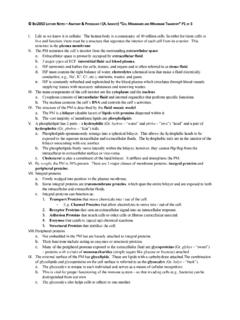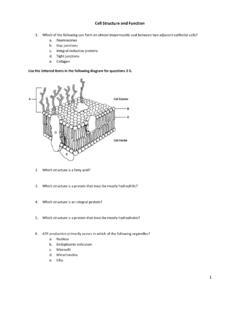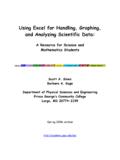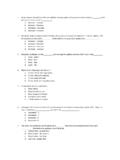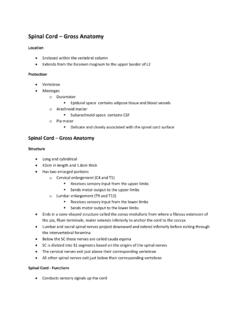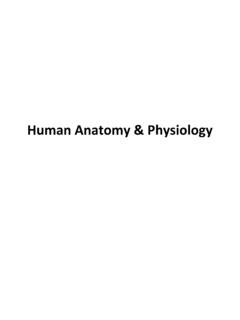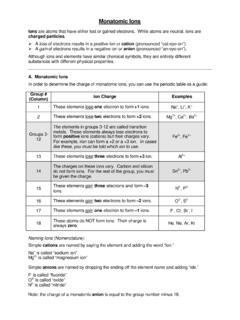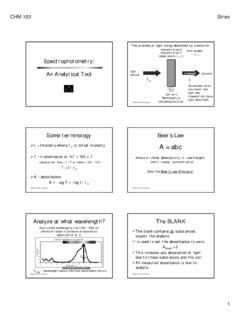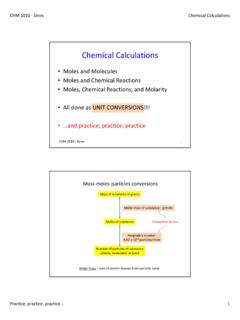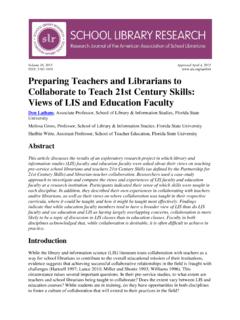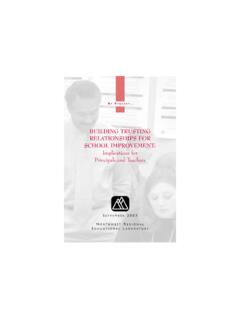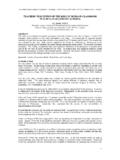Transcription of The Chemistry Resource Book Information for …
1 The Chemistry Resource book Information for elementary and Middle School Teachers Third Edition 2009 Barbara A. Gage, Editor STEM Resource Center Prince George s Community College 2009 The Chemistry Resource book Information for elementary and Middle School Teachers Third Edition Barbara A. Gage, Editor June 2009 ii This book is a publication of the STEM Resource Center of Prince George s Community College. Its development was supported in large part by a grant from the Maryland Higher Education Commission, Dwight D. Eisenhower Mathematics and Science Education Act, Grant Number 94-556. This substantially revised edition was funded by NSF Math Science Partnership Grant #0831970. iii TABLE OF CONTENTS Page Acknowledgements .. v Preface ..vii Introduction .. 1 Science Education: Critical Issues & Trends 5 E s Approach Concept Mapping Chapter 1 Matter: Properties, Changes, and Kinds.
2 7 Chapter 2 Atoms and Elements .. 17 Chapter 3 Molecules, Ions, and Bonding .. 27 Chapter 4 Chemical Reactions .. 37 Chapter 5 Physical States of Matter .. 47 Chapter 6 Thermal 69 Chapter 7 Solutions .. 77 Chapter 8 Acids and Bases .. 87 Chapter 9 Chemistry of Everyday Life Organic 99 Chapter 10 Chemistry of Everyday Life Biochemistry and Food Chapter 11 Chemistry at Home ..123 Appendices A. The Science Process Skills ..129 B. Science Misconception Research and Implications for 133 C. Some Chemistry 139 D. The Case for the Constructivist 143 iv vii PREFACE The Chemistry Resource book in intended for use in science workshops for elementary and middle school teachers offered through the STEM Resource Center of Prince George s Community College. It may also serve as a reference for content and useful laboratory experiences for anyone teaching Chemistry at the pre-high school level.
3 The content of this book is organized into chapters. Each chapter deals with a different Chemistry concept. These concepts have been selected because they are the big ideas in Chemistry and provide a basis for further learning in the science. Furthermore, it is anticipated that a grasp of these concepts provides a foundation for teaching the curriculum of most elementary and middle school Chemistry topics. While each chapter may stand alone, it is suggested that the concepts be studied sequentially as the concepts build one upon the other. Since teaching science involves more than just knowing the material, and it has been shown that students learn science better if they have an opportunity to discover it for themselves, each topic begins with guided inquiry hands-on activities. These laboratory activities can be employed as whole-class demonstrations, small group, or individual laboratory experiences.
4 An effort has been made to include activities that require materials and equipment available to most science classrooms, and in some cases, alternatives are suggested. Adherence to laboratory safety regulations is an uppermost consideration. These activities are followed by an elaboration of the concepts. This sequence of activities followed by discussion and practice is in keeping with current research findings about how to best structure instruction so that the construction of learners knowledge is facilitated. Also included are suggestions for warm-up exercises, thought-stimulating questions, and possible student misconceptions that may hamper student understanding of these ideas. Each concept chapter is divided into five or six sections: Section A. (Grouped together at the beginning of the book to facilitate workshop days.) Included here are laboratory activities (that in most cases can be modified for use as demonstrations).
5 These activities may be used to introduce a topic by performing the activity and having students predict outcomes. This procedure is a useful way to elicit student pre-conceptions. Data sheets have been provided, and follow-up questions and alternative materials included where possible. These procedures may be used as they appear, or modified by additions or deletions to fit the time or content requirements of the different classroom situations or grade levels. These activities also form the basis of the laboratory activities for participants in STEM Resource Center programs. Section B. This section includes background Information and explication of the topic. Examples are given and important vocabulary words are underlined. viii Section C. This section addresses common misunderstandings or misconceptions that students are known about these ideas.
6 Since many of these erroneous notions are based on common sense assessments of physical phenomenon or from misinterpretations of previous instruction, students (and teachers) have a hard time giving them up. It is very valuable to know what these ideas are before you teach a lesson on these topics since instruction can then be geared to elicit these wrong ideas and demonstrate or prove that they do not work. It has been found that students encounter difficulty in learning the real meaning (the implication of principles to real applications) of science ideas because they confuse ordinary or everyday usage of words with the specific meaning of words as they are used in scientific definitions. These common word-confusions will also be pointed out in Section C. Section D. This section contains a variety of suggestions for pre-instructional exercises, , questions or problems to get kids started into a topic by stimulating their interest.
7 Also included are knowledge-checking questions for use as follow-up exercises or for testing. A list of concepts is provided which may be used to construct concept maps of the larger target concepts. Section E. A Glossary of Terms associated with the target concepts is provided. Appendices of the Chemistry Resource book contain essays on topics of interest to science teachers prepared by experts in various fields of science education. What Research Has to Say to Science Teachers rounds out some areas of important pedagogical knowledge useful for structuring classroom presentations. Also included is Information concerning professional science teaching organizations, publications, and sources for obtaining Information about field trips or software to enrich instruction, and science careers. Section F. This section has selected web sites with Information pertinent to the chapter content.
8 1 INTRODUCTION Science Education: Critical Issues and Trends Numerous studies show that most students make up their minds about science during their early school years. Judgments such as: science is hard; it s easy; it s dumb; it s boring; it s only for boys; it s fun; or I d like to know more, are made by students based on what happens in these early experiences. What also has been established through educational research is: What teachers do have effects on these decisions. Our personal enthusiasm, the structure of our subject matter presentations, the depth of our own knowledge, our sensitivity and sense of fairness, the extent to which we make it all real and relevant, and communicate the expectation that our students should change the way they view the world as a result of their experience with science, have all been identified as pivotal factors in successful science teaching. Success in a science course can be taken as achieving good grades.
9 If everyone in an English class received A s, but never again read a book , that class was not successful. If everyone had perfect scores on a drug education test, and the used drugs well that s obvious. But we are finding that when students, even those who may have done very well on science tests, are asked to explain some aspect of the physical world, they do not use the Information they were taught in school. They rely for their answers on self generated theories based on their own personal observations. These theories are often in direct contradiction to what was taught in science class. What can be the justification for the huge expense of education, if what is learned in school, doesn t transfer to students lives when school is over? Classrooms come in many different sizes and shapes. They may be homogeneously or heterogeneously grouped. Often they are overcrowded. But regardless of the particulars, all must be places where learning occurs.
10 And this learning must be meaningful, that is, it must be available for retrieval when needed. What students learn in school should make a qualitative difference in the structure of their knowledge. New areas of science education research show great promise for helping us organize classroom practices to maximize meaningful learning. Findings from the area of cognitive psychology with its emphasis on understanding the process of human learning are being used to inform the art and science of teaching. Structuring teaching based on how people learn, is a rather exciting trend. Instead of floundering around trying innovations on a hit or miss basis, we can be guided by the basic underlying mechanisms of our ultimate enterprise, , learning. A complete understanding of human cognition is still in the future, but some important features of the process are beginning to emerge. Learning used to be viewed as a filling up with knowledge.

